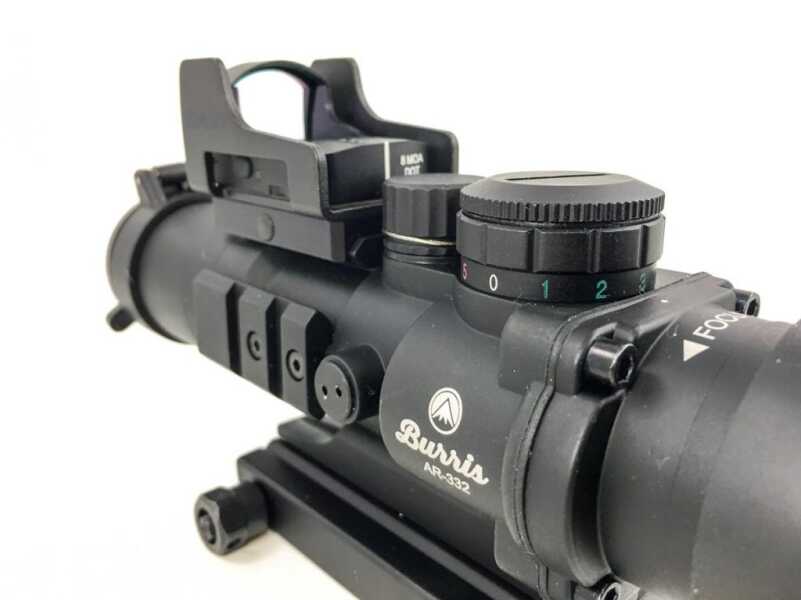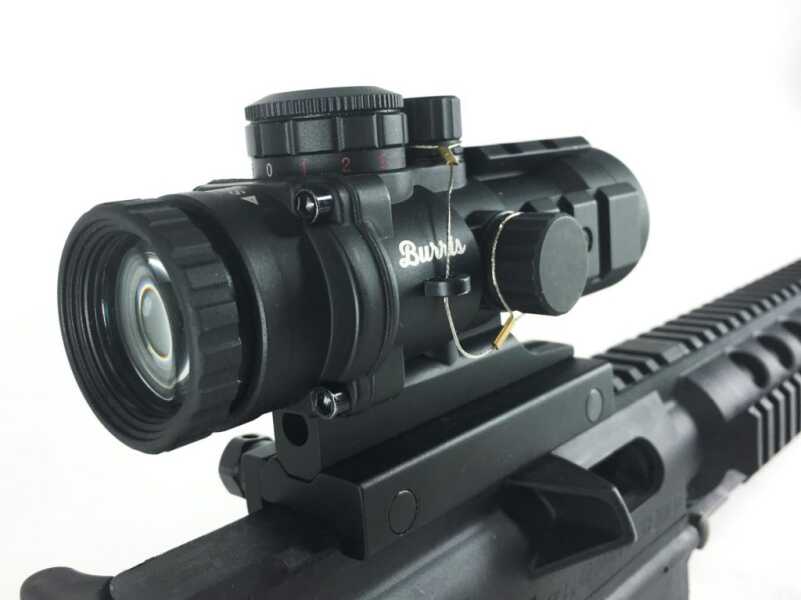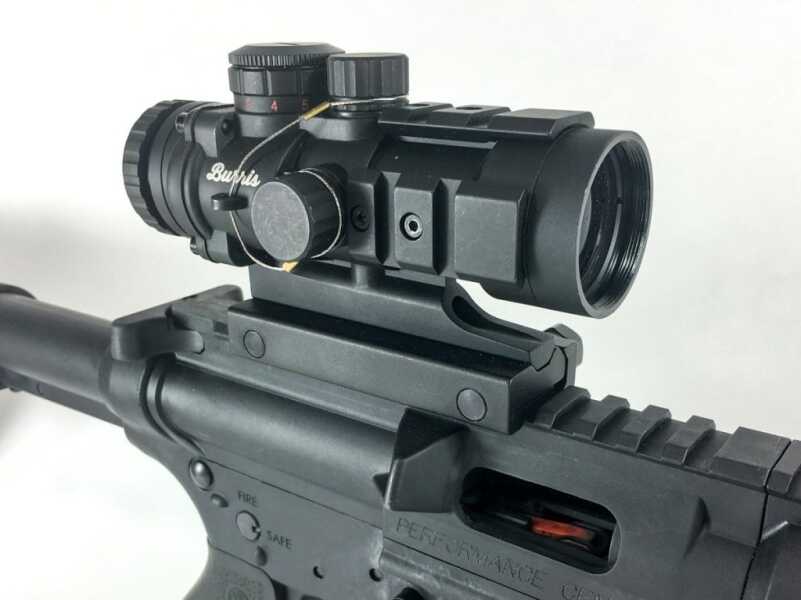

There are at least three main categories of AR optics: Red dot, fixed-power and high-magnification optics. Which should you choose?

THE SERIES
- Part 1: Optics Buying Guide: Iron Sights, Red Dots, and Scopes
- Part 2: Optics Buying Guide: Top Must-Know Terms for Picking the Right Scope
- Part 3: Optics Buying Guide: Scope Mounts
- Part 4: Optics Buying Guide: How To Properly Zero Your Scope
- Part 5: Optics Buying Guide: Finding Your Range with a Scope Reticle
- Part 6: Optics Buying Guide: Hold Off vs. Adjustable Scope Turrets
- Part 7: Optics Buying Guide: Scope Reticles
- Part 8: Optics Buying Guide: Using a Laser Rangefinding Scope
- Part 9: Optics Buying Guide: Holographic and Red Dot Optics
- Part 10: Optics Buying Guide: AR-15 Optics and Scopes
- Part 11: Optics Buying Guide: Big Scopes
- Part 12: Optics Buying Guide: Do You Get What You Pay For?
There are plenty of reasons that the AR-15 has become so popular. It’s handy, easy to shoot, configurable, multi-caliber, and has low recoil. Oh, and it’s just plain fun.
Matching the seemingly infinite number of AR rifles on the market is a multitude of suitable optics. Red dots, holographic sights, fixed-power scopes and variable-power scopes fill the shelves, so how do you choose? Let’s take a look at some factors to consider, then we’ll discuss some pros and cons of some of the common categories of AR-15 optics.
What’s your range?
Step one to finding the perfect optic for your AR-type rifle is to figure out what your most likely range requirements are. In other words, at what distance will you want or need to shoot it most of the time?
Home and Property Defense: If it’s for home defense, the distance will be measured in feet unless you live in the boonies, in which case you need to account for extremely short distances and possibly medium range, too. Just remember, self-defense only applies if you are in direct and immediate danger, so while the ability to reach out at a distance may sound appealing on the surface, it may not be a realistic defensive scenario.
Critter Patrol: Maybe your AR rifle requirements relate to varmint control. Got things like coyotes getting into your business? Depending on the type of critter (coyotes, prairie dogs, etc.) you might want to hit very small targets hundreds of yards away.
Hunting: If you hunt with an AR-type rifle, you might be into alternate calibers that increase effective range. Then again, terrain and ethical considerations may limit your realistic ranges to a hundred or so yards anyway. Depending on the type of game you are after, you may want to limit your range based on the kinetic energy available at the target. For example, if you want 1,000 foot-pounds of energy at the target, that limits the standard AR-15 with 55-grain bullets to about 115 yards. Of course, alternate calibers will extend that energy-based effective range.
Precision Shooting: Perhaps you want to limit range based on predictable performance at supersonic projectile velocity. That standard 55-grain bullet will go trans-sonic at about 850 yards, which is arguably farther than the cartridge was designed for anyway. However, if you have an alternate caliber AR-type rifle chambered in something like 6.5 Creedmoor, you can stay supersonic, and have predictable drop, out past 1,500 yards depending on conditions.
Once you’ve got your most probable usage scenarios worked out, you can evaluate the different categories of optics alternatives. There are three general categories: Zero magnification, low fixed magnification and magnified rifle scopes. Let’s take a closer look at each along with their respective pros and cons.
Zero Magnification Optics
Commonly referred to as “red dot sights,” for selection purposes it might be easier to think in terms of zero magnification optics. Whether the underlying technology can be either reflex or holographic (see the most recent feature in this series, Optics Buying Guide: Holographic and Red Dot Optics for more detail), the end result is mostly the same. You look through a piece of glass mounted in a small frame or tube and see a dot or reticle superimposed on your target. There is no magnification, so when you view your sight picture with both eyes open, you’ll see a perfectly natural view, just with a dot or reticle hovering out in space.
Zero magnification may sound scary and imprecise, but it’s really not, especially at ranges appropriate for the .223 Remington / 5.66mm AR-15. Most people would agree that shooting at something 500 yards away is stretching the capability of that cartridge, but good marksmanship skills will allow you to hit a target at that range with a simple red dot sight. Let’s look at the math to see how the view and aiming dot look at different ranges.
The Burris FastFire 3 is a classic example of a red dot reflex sight, and you can mount on in just about any gun, handgun, shotgun or AR-rifle. You can even mount one on a magnified optic so a slight shift of your head will give you either a view through your magnified scope or the red dot sight. Anyway, the FastFire 3 can be ordered with a three-minute of angle (MOA) dot size, so here’s the size of that dot at different ranges:
50 yards: 1.5 inches
100 yards: 3 inches
200 yards: 6 inches
300 yards: 9 inches
400 yards: 12 inches
500 yards: 15 inches
Of course, your eye limits your ability to see and identify targets as you move farther away, but even a 3 MOA dot has enough “precision” to hit a target surprisingly far away.
Of course, the big benefit to zero magnification optics like the FastFire is speed and field of view. They’re insensitive (and that’s a good thing) to your exact face position relative to the optic, so you can raise your gun and see both dot and target quickly and easily.
Low-power Fixed Magnification Optics
One category of AR optics is the fixed low power optic. They typically look like a red dot tube sight, but have built-in magnification of 2,3, 4, and sometimes 5x. A perfect example is the Burris AR-332 Prism Sight. This optic features a constant 3x magnification and a reticle designed to offer speed and a reasonable degree of precision at longer ranges. It’s even got bullet drop compensation indicators that give you hold points good to 600 yards.
What makes these types of optics interesting for AR use is the ability to use them like a zero magnification red dot. You can, and usually should, shoot with both eyes open, so you have a great situational view but with a little magnification assistance for precision when you want it.
You also can’t beat the simplicity. No dials, no need to remember where you left the magnification setting: Just pick up the rifle and use it. While reticles are usually illuminated, as with the AR-332, the design is thick enough that it’s still easy to see in daylight whether you have the illumination turned on or not.
As the name implies, they’re really designed for traditional AR-15 rifles, but they also make a great fit for rimfire rifles. I’ve been using the one shown here on a Smith & Wesson M&P 15-22, and it’s going to stay there, probably forever. The 3x magnification is perfect for .22LR ranges – great for 25 yards or over 100.
Rifle Scopes
While some rifle scopes offer fixed magnification like 10x, most offer variable magnification which allows the user to change the magnification power level from low for closer range application to high power for longer range precision. Common general purpose scopes might have 3-9x, 4.5-14x, 5-25x or any nearly any other combination of magnification. If your plan is to shoot at longer range, then, by all means, knock yourself out with one of the classics like this.

Depending on what you want to do, a more traditional scope like this Burris XTR II 2-10x can make sense too.
However, there’s a sub-category that’s particularly well-suited for AR-15 use. The AR-15 is a little bit unique in that it’s a great solution for close-quarters application. However, a high-power scope is awkward and impractical for very short range use. The more you magnify, the less you see in your field of view, so the harder it is to find and transition between targets. For this reason, a whole series of low magnification scopes has entered the AR-15 market. Examples include the Burris MTAC 1-4x24mm and 1.5x6x42mm models. With the low end of magnification being 1x (zero magnification) or 1.5x, they operate much like a red dot sight at that setting. With a smart reticle design, the low power settings offer an easy-to-see ring that allows for fast targeting and short ranges. The Burris CQ reticle is a great example. A large thick ring provides speed at close range. Inside that ring, you’ll see more traditional crosshairs and dots for range compensation. The Burris Ballistic AR reticle takes a slightly different approach, overlaying part of a thick circle on a traditional crosshair setup. Depending on your magnification level and distance, you simply use different parts of the reticle for aiming.
[one_half]
[/one_half]
[one_half_last]
[/one_half_last]
You also might consider first focal plane (FFP) scopes to provide short and long range flexibility. For a more detailed explanation of what these are, refer back to the Optics Buying Guide: Top Must-Know Terms for Picking the Right Scope article, earlier in this series. In short, the entire reticle pattern grows and shrinks as you change magnification. With a smart reticle design, the reticle looks and acts like a red dot sight at low magnification, so a simple spin of the magnification ring essentially converts your scope between a red dot-like optic and traditional rifle scope.
Whatever approach you choose, be wary of the temptation of over-magnification. When plinking on the range, it’s fun to dial the power way up so you can take aim at very small targets far away. If you plan to use your rifle for defensive, hunting or competition purposes, you might be better served by sacrificing some high-end magnification for better field of view. At high magnification levels, you only see a very small area down range. For example, with the Burris XTR II 5-25x50mm scope, you only see an area 4.3 feet wide at 100 yards when you have the magnification set at 25 power. That’s fine, and even desirable, for certain applications. Just be aware of those types of tradeoffs when you’re choosing your optic.
Besides, you might be surprised at how well you can hit relatively small targets at range using a lower power optic. With less of the visible “wobble” you’ll see at high magnification levels, you can focus on your shot rather than fight the distractions of crosshair movement. Most rifleman training programs like the Appleseed Project will have you hitting man-sized targets at 500 yards using only iron sights in no time. Now, imagine what you can do with four or six power magnification.

You can also choose both red dot and magnified optic. The Burris AR-332 and FastFire 3 both have mount options that allow them to work together.
Summing it up
Everyone’s requirements and preferences are different, so it’s impossible to recommend the “right” solution for an AR-rifle. What we’ve tried to do here is point out the pros and cons of the three main approaches to AR optics. If I can inject one opinion into your decision process, it would be this: The AR rifle is designed to be quick, handy and flexible for short to intermediate range. As a result, it pairs exceptionally well with lower magnification optics, whether that is zero or somewhere in the single digits. If you’re torn as to what magnification range to choose, consider erring on the side of lower rather than higher.





Very, very nice series of articles. I’ve never owned a scope, and had no idea there was so much to ‘just right’. As far as the ‘advertising’ comment, some one has to front the scopes, or Mr. McHale will have to buy all of them. Using one brand helps simplify a complex series of information. But even I knew there was more than one brand, and that this was not a review. Recognizing an area of ignorance is not the same as admitting incompetence.
What about pistol caliber carbines? They’re becoming very popular. Any recommendations for them?
Aimpoint clone like the primary arms micro dot or holosun. Thats what’s lived on my UMP .45 since day 1 and never fails. Plus, I’ll never shoot that past 50 yards, so it’s perfect.
I have an Aimpoint Comp M4 on one of my weapons and a Burris red dot on another. One backed with a Primary Arms 3X magnifier and the other with a 3X from EOtech that works perfectly. The magnifiers are mounted on a flip to the side mounts that allow me to go CQB or BUIS with a flip of a lever. The sights are both perfectly centered with the BUIS as long as the magnifiers are flipped to the side. I have taken many coyotes with this setup out beyond 100 yards with ease. Even running yotes. I do have my pig AR that is set up with a thermal in 6.5 Grendel in case I need to reach out past 300 yards.
First of all I’ll say ” I live in the brush/wooded covered boonies & use my rifle for most of my shooting requirements “. I use a good quality 2-7x 32 scope zeroed to 150 yds. I found that most AR optics have a 20 to 24 lenses which doesn’t allow enough low level light for me. I can shoot it on 2 power with both eyes open or crank it up to 7 for a small target at 200 yds. NO batteries required !
I agree with you…most of my long guns end up with a 2-7x Leupold scope. If I ever built a long range target gun, or small varmint gun, I’d probably consider a higher magnification.
I bought a 1-7x Leopold for one of my ARs and have now ruined all other scopes for me.
Question about the gas block: I have a standard iron sight front gas block. Would I need a riser to see over that or (as I overheard) it doesn’t matter, you don’t see it anyway.
And as for risers – any advice?
I use a 1/2″ riser & a high set of rings for a scope. Mainly for a preferred cheek point of contact. It’s more about your personal preference & fit than anything, no my front sight can’t been seen. You have to experiment for you best fit !
So this is just one big advertisement for burris?
If you hadn’t noticed, Burris generously sponsored this entire 12-part series and the associated 20,000 words of educational content about optics science and usage scenarios. Are you really that offended that Burris products are used here as the examples to illustrate educational concepts made throughout the series?
Production of educational content isn’t free – it takes plenty of work and labor to produce stuff that’s available free for readers – that cost has to come from somewhere. If you look at the series page, it’s abundantly clear that Burris is the sponsor of the entire series. Sheesh.
Did I say I was offended? In fact I think it is a very informative piece.
Burris is very generous in sponsoring it , but most sponsers understand that if your doing such an in depth piece you other options should be discussed, not just one offering and one offering only, by all means highlight the fine line of burris optics ,they are great, but even burris knows there is more than one brand of optic made. I am by no means upset just stating a fact.
Scope Guy- I agree 100%. But, like everything else you read, you can still get something from it, just consider the source.
Mr. McHale- Why take offense to Scope Guy’s comment? Is he wrong? No, his assessment was spot on. It seems to me you must work in the industry, for Burris etc…just from the fact that you said “Burris generously sponsored this entire…..”. Really, no one reading reviews, help guides, etc cares who pays for it. At the very least, GA ‘articles’ should start with a disclaimer at the top of the page informing the reader of any sponsors. That would at least educate the reader beforehand.
So this is just one big advertisement for burris.